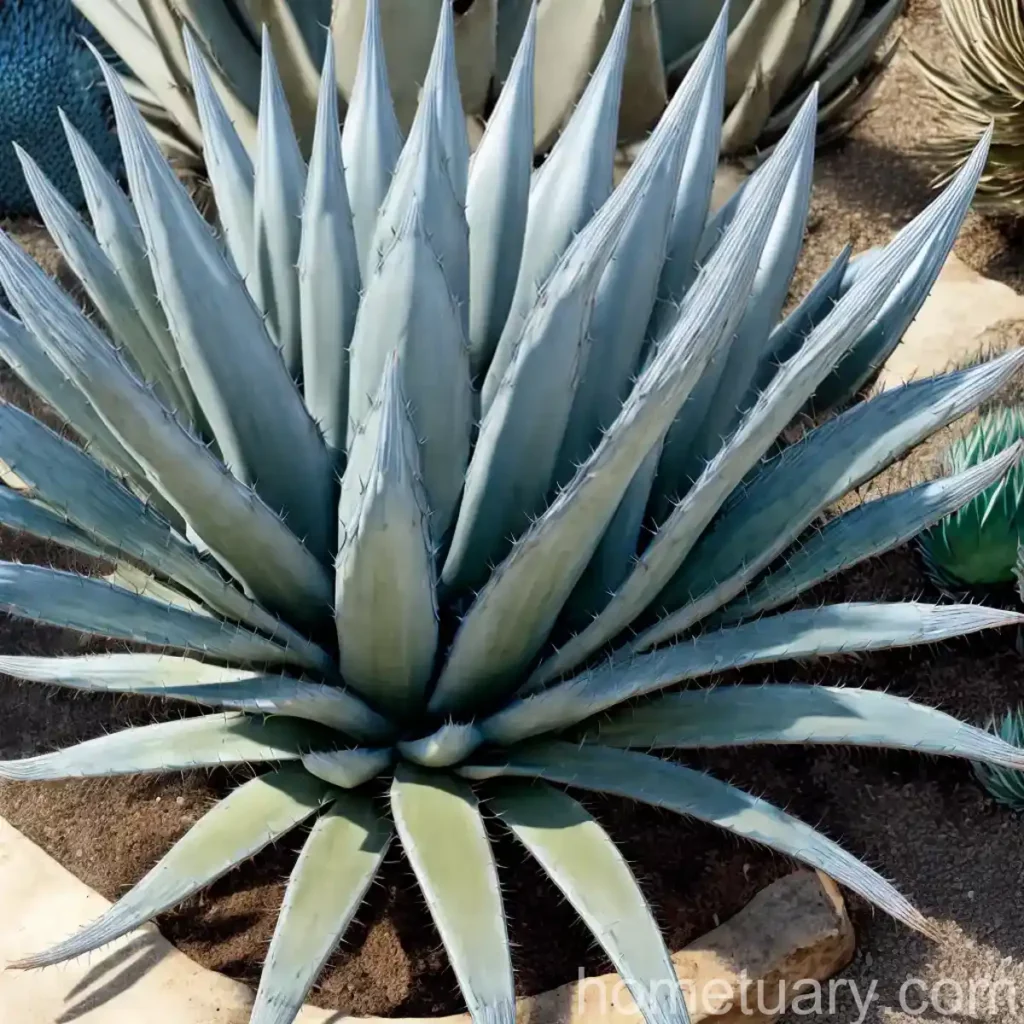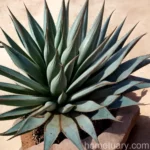The Enigmatic Century Plant (Agave ‘Blue Glow’)
The Agave ‘Blue Glow’, also known as the century plant, is a stunning plant with striking architectural form and visual appeal. This succulent is a popular choice for arid and xeriscape landscapes due to its low-maintenance nature and tolerance for drought conditions. In this comprehensive guide, we will delve into the various aspects of the century plant, including its culture, uses, maintenance requirements, and much more. Let’s embark on a captivating journey through the captivating world of Agave ‘Blue Glow’.
What is the Century Plant (Agave ‘Blue Glow’)?
The century plant, scientifically known as Agave ‘Blue Glow’, is a distinctive succulent belonging to the Agave genus. It is a hybrid variety, created from the crossing of Agave attenuata and Agave ocahui. This striking plant is characterized by its rosette of thick, spiky, blue-green leaves with a subtle luminous quality. The ‘Blue Glow’ cultivar, in particular, is revered for its intense blue-green foliage, which emanates a captivating radiance when backlit by the sun. The century plant is named for its reputation of blooming once every century, although in reality, it typically flowers between 10 to 30 years of age.
Key Takeaways – Century Plant (Agave ‘Blue Glow’)
Before we delve deeper into the specifics of the Agave ‘Blue Glow’, let’s outline the key takeaways that will guide our exploration:
- Classification: Succulent plant, Agave species
- Characteristics: Rosette of blue-green, spiky leaves with a luminous quality
- Hybrid Origins: Cross between Agave attenuata and Agave ocahui
- Bloom Frequency: Typically flowers between 10 to 30 years of age
- Usage: Popular in arid and xeriscape landscapes
- Low-Maintenance: Tolerant of drought and low-maintenance requirements
Now, let’s delve into the various facets of this captivating plant.
Culture of the Century Plant
To truly appreciate the beauty and majesty of the century plant, it is essential to understand its cultural requirements and the conditions that will allow it to thrive. Proper culture is integral to the health and longevity of the Agave ‘Blue Glow’.
Uses
The century plant holds a myriad of uses, both practical and aesthetic, that make it a valuable addition to diverse landscapes:
- Landscape Focal Point: The distinct form and striking foliage of the ‘Blue Glow’ cultivar make it an excellent focal point in garden and landscape designs.
- Xeriscaping: Due to its remarkable drought tolerance, the century plant is an ideal choice for xeriscape gardens and arid landscapes.
- Container Gardening: Its low-maintenance nature and striking appearance render it a popular choice for container gardening, adding a touch of elegance to outdoor spaces.
- Architectural Accent: Its architectural form and radiant foliage lend a dramatic and contemporary appeal to gardens and landscapes.
- Medicinal Properties: Certain species of Agave are traditionally used in herbal medicine and for the production of beverages such as tequila and mezcal.
Water
One of the most critical factors in the care of Agave ‘Blue Glow’ is proper watering. This succulent’s water requirements align with its natural habitat in arid regions.
- Established Plants: Once established, century plants are exceptionally drought-tolerant and require infrequent watering. They are well-suited to dry, arid climates and should not be overwatered.
- Establishing New Plants: During the initial establishment phase, provide regular watering to promote root development. Select well-draining soil to prevent waterlogging, and allow the soil to dry out between waterings.
Sunlight
Unsurprisingly, sunlight plays a crucial role in the life and vitality of the Agave ‘Blue Glow’. Understanding its sunlight requirements is fundamental for its well-being.
- Full Sun Exposure: Agave ‘Blue Glow’ thrives in full sun and requires at least six hours of direct sunlight per day to maintain its vibrant coloration and form.
- Partial Shade: While tolerant of partial shade, prolonged low light conditions may lead to leggy growth and a diminished visual appeal.
Fertilizer
Unlike many other ornamental plants, century plants have relatively low nutrient requirements and do not demand frequent fertilization.
- Minimal Fertilization: A balanced, slow-release fertilizer applied in the spring can provide the necessary nutrients for healthy growth.
- Avoid Overfertilization: Excessive fertilization can lead to rapid, succulent growth that may compromise the plant’s structural integrity, so it is advisable to use a diluted fertilizer solution sparingly.
Soil
Optimal soil conditions are essential for ensuring the health and vigor of the century plant. The ideal soil should facilitate drainage and nutrient uptake.
- Well-Draining Soil: Agave ‘Blue Glow’ thrives in well-draining soil with a gritty texture. This prevents waterlogging and mitigates the risk of root rot.
- Sandy Loam Mix: A sandy loam mix with good aeration is well-suited for cultivating century plants.
Pruning
Pruning is an aspect of maintenance that is often overlooked in succulent plant care. However, correct pruning techniques can enhance the visual appeal and longevity of the century plant.
- Pruning Dead Leaves: Remove dead or damaged leaves by gently pulling them downward to facilitate healing and prevent rot.
- Minimal Pruning: Century plants generally require minimal pruning due to their slow growth and self-reliant nature.
Propagation of Agave ‘Blue Glow’
Understanding the process of propagation is fundamental for cultivating and expanding the presence of the Agave ‘Blue Glow’.
Offsets
The most common method of propagating century plants is through the use of offset, or pups, that emerge from the base of mature plants.
- Offset Collection: Carefully remove offsets from the parent plant using a sharp, sterile knife. Allow the cuts to callus before planting.
- Propagation Medium: Plant the offsets in a well-draining propagation medium and water sparingly until they establish roots.
Seeds
While less common, century plants can also be propagated from seeds, although this method requires patience and time.
- Seed Collection: Collect ripe seeds from mature century plants and sow them in well-draining soil in containers or seed beds.
- Germination: Provide warmth and consistent moisture for seed germination, and transplant the seedlings once they have developed sufficient root systems.
Container Cultivation of Agave ‘Blue Glow’
The captivating form and low-maintenance requirements of the century plant make it an excellent candidate for container cultivation.
Popularity in Containers
Agave ‘Blue Glow’ holds immense popularity in container gardening, adding a touch of elegance to outdoor spaces.
- Aesthetic Appeal: The striking visual appeal of the ‘Blue Glow’ cultivar makes it an ideal choice for ornamental container displays.
- Space Flexibility: Container cultivation allows individuals with limited outdoor space to enjoy and appreciate the beauty of century plants.
- Versatile Placement: Century plants can be placed on patios, balconies, or as interior accents to bring a touch of nature into living spaces.
Maintenance in Containers
While century plants are generally low-maintenance, certain considerations are crucial for their successful cultivation in containers.
- Drainage: Ensure that containers have adequate drainage holes to prevent waterlogging, which can lead to root rot.
- Size Consideration: Select a container that accommodates the mature size of the century plant, allowing ample space for root development.
- Soil Requirements: Utilize a well-draining potting mix suited for cacti and succulents to provide optimal growing conditions.
Common Diseases and Disease Diagnosis
Century plants are naturally resilient and are not prone to many diseases. However, certain conditions can lead to health issues that warrant attention.
Disease Diagnosis
Visual symptoms and signs can aid in diagnosing potential diseases and issues affecting the health of century plants.
- Root Rot: Yellowing or wilting of lower leaves and a foul odor emanating from the soil may indicate root rot due to overwatering or poor drainage.
- Leaf Spotting: Fungal infections may manifest as discolored spots on the leaves, which can spread and compromise the overall health of the plant.
Common Diseases
Despite their hardy nature, century plants can fall victim to a few diseases, particularly under unfavorable growing conditions.
- Root Rot: Excessive moisture or poor drainage can lead to root rot, which can be detrimental to the health of the plant.
- Leaf Spot Diseases: Fungal pathogens can cause unsightly spotting on the foliage, potentially impacting the plant’s ability to photosynthesize.
Common Pests and Pest Control
While robust and resilient, century plants may occasionally encounter pest-related issues that require control measures.
Common Pests
Certain pests can pose a threat to the health of century plants, particularly when grown under stress or suboptimal conditions.
- Spider Mites: These tiny pests often infest the undersides of leaves, causing stippling and webbing that can compromise the plant’s health.
- Mealybugs: Mealybugs may congregate in leaf axils and other crevices, sapping the plant’s vital juices and potentially transmitting viral diseases.
Pest Control
Preventative measures and targeted control methods can effectively manage pest issues while minimizing harm to the century plant.
- Natural Predators: Encourage the presence of beneficial predators, such as ladybugs and lacewings, which feed on pest species.
- Horticultural Oils: Neem oil and other horticultural oils can be utilized to smother and suffocate pest populations while minimizing the risk to beneficial insects.
Botanist’s Tips for Growing Agave ‘Blue Glow’
Cultivating century plants successfully requires attention to detail and an understanding of their specific requirements.
Fun Facts
Uncover intriguing and captivating facts that highlight the unique qualities and allure of the century plant.
- Agave Diversity: The Agave genus encompasses a diverse array of species, ranging from diminutive rosette-forming succulents to immense, architectural species.
- Tequila Production: Certain species of Agave, notably Agave tequilana, are utilized in the production of tequila, a renowned Mexican spirit.
- Ornamental Value: Beyond their utilitarian uses, numerous Agave species, including the ‘Blue Glow’, hold significant ornamental value, captivating the hearts of plant enthusiasts and horticulturists alike.
Links to External Resources
Expand your knowledge and appreciation of the captivating century plant through these valuable external resources:
- Agave ‘Blue Glow’ – University of California Agriculture and Natural Resources
- Agave care: A simple, but definitive guide – San Marcos Growers
- Agave Cultivation and Production – Food and Agriculture Organization of the United Nations
With its striking form, low-maintenance nature, and diverse uses, the century plant (Agave ‘Blue Glow’) stands as a captivating symbol of resilience and natural beauty in gardens and landscapes. Whether planted as a solitary focal point or incorporated in xeriscape designs, the majestic ‘Blue Glow’ cultivar exudes a uniquely enchanting allure that captivates the hearts of plant enthusiasts, horticulturists, and nature aficionados alike.















